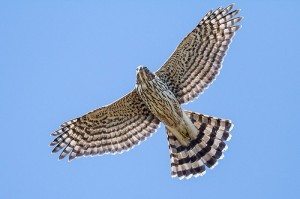Report from Hawk Hill, Part 2
Each fall, hundreds of volunteers with the Golden Gate Raptor Observatory track hawk migration through the Bay Area. To celebrate fall migration, here’s the second installment in a two-part interview with GGRO Director Allen Fish.
—————————
Q: What trends have you seen in recent years in terms of numbers, species, timing, anything else?
A: With 19 species of annual raptors, and a quarter-century of data, I could spend days on this question, but to give a few examples:
- Peregrine Falcon numbers have increased steadily over the 25 years of the GGRO count. In 1985, we tallied one Peregrine every 200 or so count-hours at GGRO; today we see a Peregrine just about every other hour.
- We have started to mine our data for phenological changes — that is, changes in peak dates of migration that might be attributed to climate change. Sharp-shinned Hawks seem to show some slippage of their peak dates over time, but the statisticians are still working on their part of the analysis, so I better not say too much.
Q: How many volunteers do you have counting on weekdays? On weekends?
A: Weekday counters, about 80 volunteers. Weekend, about 60. A volunteer makes a commitment to one weekday or weekend day every other week from August through December. An exceptionally experienced volunteer with five to 25 years’ experience is the leader for the day. He or she tries to see and corroborate every raptor.
Q: How does the Quadrant System work? Does it keep you from counting the same hawk multiple times? How was it created?
A: We split the 360-degree view-shed on Hawk Hill into four impossibly huge slices of pie that we call quadrants. Two to three volunteers focus on one of these quadrants for an hour at a time trying to see every new raptor, and to pass every previously spotted raptor. If we’re not sure whether a hawk has been counted already, we count it. One person records species, ages, and sexes for the whole team.
Nothing can keep a human being from counting the same hawk multiple times on Hawk Hill. We have learned from band recoveries and radio-tracking studies that raptors may leave Marin and come back days or even months later. So how do we account for “double-counts?” First off, we assume they happen. And that they happen at some regular rate that stays consistent from year to year. And then we do not purport to count some absolute number of raptors each day passing by the Marin Headlands. Let me explain.
We may count 300 Cooper’s Hawk sightings in one day, but we will never ever know how many Cooper’s Hawks exactly passed through Marin County on that day. What we can know is that, for instance, 300 Cooper’s Hawk-sightings were tallied in a six-hour daily count. Or that we measured 50 Cooper’s Hawk-sightings per hour on that particular day.
The Quadrant System was created by a group of volunteers and me in 1988. We were trying to devise a long-term raptor-counting system that could be repeatable by different teams, whether those teams were days or decades apart. We tried to invent a system that valued anybody’s ability to be a raptor-spotter regardless of whether they could tell a Sharp-shinned from a Cooper’ Hawk.

Q: If someone wants to get involved, what should they do? Just show up with their binoculars? Do they need to be a skilled birder to take part in the count?
A: To be an official counter for GGRO you must attend a springtime recruitment class, apply on paper, be interviewed, and then be accepted. Then we ask you to take some 15 hours of June and July classes on raptor biology and species identification before you go in the field in August. Some of our people are not experienced birders but most have some birding or biological field work experience. Standing at attention and scanning for hawks for six hours is a bigger aerobic experience than most people are used to.
If you want to get involved with GGRO during the fall and haven’t gone through the process above, just come out and watch hawks with us casually. This will give you a full picture of what it is to volunteer with us, and you can come and go as you please. You can ask questions, without the pressure to stay in one quadrant for an hour. And yes, binoculars do help a lot. Hawk watchers tend to prefer wide-angle binocs which allow you to see the biggest possible piece of the sky.

Q: What advice can you offer people who are just learning to identify raptors? What clues or characteristics do you personally find most helpful in differentiating the various species?
A: Great question. First off, there’s a lot to learn about raptor identification, so be humble. Take notes. Write in your field guide, and ask a lot of questions of people who seem to know more than you about raptor identification. Take their answers with a grain of salt until you have tested them in the field to see if they work for you. Go outside and watch raptors. Field time is your best teacher, and the Bay Area is blessed by geography and climate. We have great raptor watching spots in close range: outer Point Reyes, Mount Diablo, Suisun Marsh, the Baylands, the San Mateo coast, the Delta, Altamont Pass, Mines Road, Pinnacles, the Sierra Foothills, the Sacramento Valley refuges, and the Klamath-Tule lake refuges.
We have great raptor field guides available now, and in the next few years, there will be a small explosion in raptor field guides. For specializing, the Peterson Guide to Hawks and Hawks in Flight, second edition, are great places to start. For broader field guides, I like the newest National Geographic guide and Sibley.
The Big Problem with hawks and maybe all birds is that – in most field guides — you often get two flying bird paintings to represent the perhaps one dozen different plumages that you NEED in order to really recognize that bird in the field: adult, juvenile, sub-adult, male, female, light, dark, and intermediate morphs, molting birds, low light, angled light, backlit, high winds, hot days, dorsal view, ventral view, front, back and side views, skewed angles. You get the idea. Each of these is a different painting or photo. Author and raptor expert Jerry Liguori has worked harder than most to try and depict the range of “looks” that a raptor can impart in his two books Hawks from Every Angle and Hawks at a Distance, but these are truly advanced books that might blow the patagials off the less experienced people in the room.

What do I find most useful for identifying? I was about to write a paragraph about studying raptor behavior, but the real utility here is your patience and focus. You cannot watch enough Red-tailed Hawks. Spend years looking at Redtails doing every behavior in every angle of light, in every plumage. Redtails are wonderfully available to us in California, as are Turkey Vultures and American Kestrels.
Yes, we all want to see a Ferruginous Hawk or a Prairie Falcon, but if you have a Red-tailed Hawk in good light in front of you, then sit still and shut up, put up your binos, and just watch. Ask yourself every time it turns a degree in the sky, how would I know it’s a Redtail now? I may not make friends by saying so, but I would much rather hang out with the person who can spend an hour really studying how a Redtail behaves than with the person who can list 20 bird species in the same hour in the same location. But that’s just me.
——————————–
You can read Part 1 of this interview at https://goldengatebirdalliance.org/blog-posts/report-from-hawk-hill-part-1/. To learn more about Golden Gate Raptor Observatory, see www.ggro.org.

